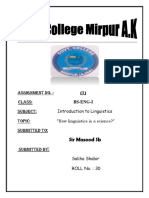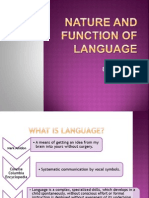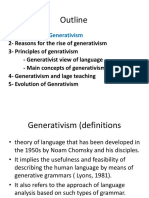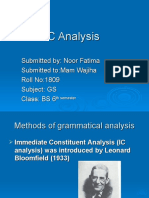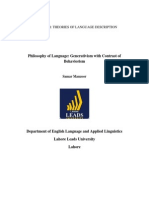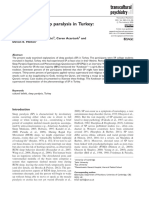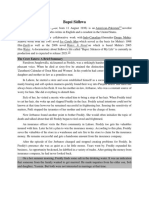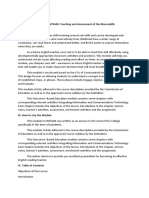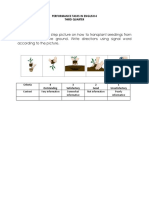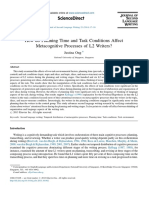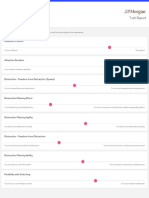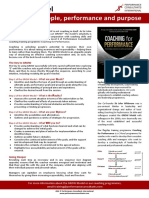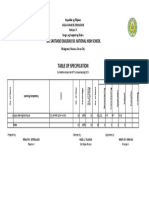Characteristic of Language
Uploaded by
Gulfam RiazCharacteristic of Language
Uploaded by
Gulfam Riaz1
Properties /Characteristics of Language
Definition of Language
Many definitions of language have been proposed. Henry Sweet, an English phonetician and
language scholar, stated: “Language is the expression of ideas by means of speech-sounds
combined into words. Words are combined into sentences, this combination answering to that
of ideas into thoughts.”
The American linguists Bernard Bloch and George L. Trager formulated the following
definition
“A Language is a system of arbitrary vocal symbols by means of which a social group
cooperates.
According to Sapir:
“Language is a purely human and non-instinctive method of communicating ideas, emotions,
and desires through a system of voluntarily produced sounds.”
Bloomfield:
“The totality of the utterances that can be made in a speech community is the language of that
speech community.”
Noam Chomsky:
“Noam Chomsky says the language is the inherent capability of the native speakers to
understand and form grammatical sentences. A language is a set of (finite or infinite)
sentences, each finite length and constructed out of a finite set of elements.”
Sir Gulfam Riaz Hashmi
M. Phil English
2
Properties /Characteristics of Language
1. Language is Arbitrary
Language is undoubtedly arbitrary as there is no inherent connection between the nature of
things or concepts the language deals with, however by which those things and concepts are
expressed. There is no reason why a ‘single term’ pronounced differently by different
communities. The decision of a word choice to mean a specific thing or idea is absolutely
arbitrary. It might be noticed that if a language is not been arbitrary, there would have been
just a single language remained throughout the world. That’s why we can consider language
as arbitrary vocal symbols.
2. Language is a Social Phenomenon
In a sense, language should be considered as a social phenomenon. Language is social that
exists in our human society; it is as a means of nourishing and developing culture and
establishing human relations. As a member of a particular social group, we human beings
interact with each other, which allows us to identify with one another, to connect with one
another and to coordinate with one another. This is how language is the part and parcel of our
society. Language exists in the public arena, is a method for feeding and creating a society,
and sets up human relations. As a member of society, we acquire a language permanently.
3. Language is a Symbolic System
Language signifies as a symbolic system. It consists of different types of sound symbols for
concepts, things, ideas, objects etc. Language has sounds and words as their symbols.These
symbols are picked and routinely acknowledged and utilized. The words in a language are not
just patterns or images but symbols that denote meaning. The language uses words essentially
as symbols and not as signs for the concept represented by them. The core value of a
language sometimes relies on the true explanation of these symbols.
4. Language is Systematic
Sir Gulfam Riaz Hashmi
M. Phil English
3
In spite of the fact that language is symbolic, its symbols are arranged in specific systems. All
languages have their arrangement of plans. Each language is an arrangement of systems.
Furthermore, all languages have phonological and syntactic systems and within a system,
there are also several sub-systems. For instance, inside the linguistic system, we have the
morphological and syntactic system, and inside these two sub-systems, we have systems, for
example, those of plural, of mindset, or perspective, of tense, etc.
5. Language is Vocal, Verbal and Sound
Language is a system of vocal and verbal symbolism. It is essentially comprised of vocal
sounds just created by a physiological articulatory component in the human body. First and
foremost, it shows up as vocal sounds only. Language takes verbal elements such as sounds,
words and phrases which are fixed up in certain ways to make several sentences. Language is
vocal and sound which is produced by different speech organs. Writing can be considered as
an intelligent platform to represent vocal sounds. It is the graphic representation of the speech
sounds of the language.
6. Language is Non-Instinctive, Conventional
No language was made in multi-day out of a commonly settled upon the recipe by a gathering
of people. Language is the result of advancement and tradition. Every age transmits this
tradition on to the following. Like every single human organization, languages may also
change and pass on, develop and extend. Each language has a circulation in a particular
community around the globe. However, we can consider language as non-instinctive because
naturally it is acquired by us.
7. Language is Productive and Creative
Language has its own efficiency and innovativeness. The auxiliary components of human
language joined to create new expressions, which neither the speaker nor his/her listeners
may ever have made or heard previously. Truly, the two sides comprehend without trouble.
Language can be changed as indicated by the necessities of human society. After all,
language has the power of productivity and creativity.
8. Language is a System of Communication
Sir Gulfam Riaz Hashmi
M. Phil English
4
Language is strong, convenient and the best form of communication for no doubt. It is the
best way to express everything. It is through language that we human beings express our
thoughts, desires, emotions and feelings. Further, we can interact with each other easily
through the welfare of language. After all, we may say that language is the best system of
communication around the world.
9. Language is Human and Structurally Complex
Human language is open-minded, extendable and modifiable in contrary to animal language.
Language should be modifiable through time to time. No species other than human beings
have been endowed with the language. So we can say that language is naturally human and in
some cases, structurally complex and modifiable.
10. Language is Unique, Complex and Modifiable
It’s true that language is a unique phenomenon in the world. Every language has its own
characteristics and distinctive features. Furthermore, each language has its own creativity and
productivity to deliver the best ways in order to communicate with each other. And this is
how language has its own potentiality to be unique, complex and modifiable by the change of
time and culture.
11. Cultural Transmission:
A language can be culturally transmitted. It cannot be transmitted through heredity. Animals
transmit their cries through heredity. What language the baby is going to speak is determined
by the culture the baby is born into. Infants are born without an ability to use the language of
their societies. By observing and listening carefully for the first few years, those children
learn the unique usages of the language of their culture. This is why it is crucial to talk often
to even the youngest children and to engage them as much as possible in conversation.
12. Displacement:
Human language can refer to the past and future times. Human language isn't simply limited
to describing what is tangible in the present. It can be used to describe or imagine things by
people who are not in that immediate situation. This allows for humans to discuss history and
to imagine a future. We can refer to the things and events that are not present, intangible,
Sir Gulfam Riaz Hashmi
M. Phil English
5
non-existence and non-visible. For Example: moon, star, dragons, math’s equations, heaven
and hell etc.
13. Duality:
Human language is organized at two levels simultaneously. For example, at speech
production we have a physical level at which we can produce individual sounds like n, b and
i. In a particular combination such as ‘bin’ we have another level producing a meaning that is
different from the meaning of the combination in ‘nib’. • In animals there is only one level
that is sound.
14. Discreteness:
Sounds in human language are different, they are separate from one another whereas sounds
of animals are the same, and they cannot be separated. Discreteness in language describes the
fact that human language is composed of sets of distinct sounds. One sound on its own may
convey one meaning, multiple sounds combined in a particular order convey a different
meaning. Even repeated sounds have a particular meaning.
Conclusion
After the above discussion, we come to the conclusion that Language, a system of
conventional spoken, manual (signed), or written symbols by means of which human beings,
as members of a social group and participants in its culture, express themselves. And the
above mentioned characteristics of a language are the part and parcel to build the authenticity
of any language.
Sir Gulfam Riaz Hashmi
M. Phil English
You might also like
- Wendy Conklin - Higher-Order Thinking Skills To Develop 21st Century Learners67% (3)Wendy Conklin - Higher-Order Thinking Skills To Develop 21st Century Learners24 pages
- Definition, Nature and Scope of Linguistics100% (3)Definition, Nature and Scope of Linguistics6 pages
- Chapter One: 1.1. Language Learning and Acquisition100% (1)Chapter One: 1.1. Language Learning and Acquisition14 pages
- Mentalism or Mentalist Theory: Noam Chomsky90% (10)Mentalism or Mentalist Theory: Noam Chomsky5 pages
- Ivana Marková - The Dialogical Mind - Common Sense and Ethics (2016, Cambridge Univertisy Press) PDFNo ratings yetIvana Marková - The Dialogical Mind - Common Sense and Ethics (2016, Cambridge Univertisy Press) PDF257 pages
- Language: Definition, Nature, and Characteristics Definitions of LanguageNo ratings yetLanguage: Definition, Nature, and Characteristics Definitions of Language3 pages
- The Nature of and Characteristics of Language100% (1)The Nature of and Characteristics of Language13 pages
- Introduction To Linguistics Lesson One Handouts100% (1)Introduction To Linguistics Lesson One Handouts5 pages
- Tumapon - Strengths and Weaknesses of Language Origin TheoriesNo ratings yetTumapon - Strengths and Weaknesses of Language Origin Theories3 pages
- ML2 Structural Linguistics and Behavioural PsychologyNo ratings yetML2 Structural Linguistics and Behavioural Psychology34 pages
- Assignment No. 2 Name: Wali Hussain Class: BS English Literature Assignment: Linguistics Semester: 2 Semester Teacher: Prof. Umer AzeemNo ratings yetAssignment No. 2 Name: Wali Hussain Class: BS English Literature Assignment: Linguistics Semester: 2 Semester Teacher: Prof. Umer Azeem10 pages
- Course Title: ENG-110.01-Composition I: BS English Lecture Notes 3 Topic100% (6)Course Title: ENG-110.01-Composition I: BS English Lecture Notes 3 Topic3 pages
- Beliefs About Sleep Paralysis in Turkey: Karabasan AttackNo ratings yetBeliefs About Sleep Paralysis in Turkey: Karabasan Attack13 pages
- Course Title: ENG-110-Composition I: BS English Lecture Notes 13No ratings yetCourse Title: ENG-110-Composition I: BS English Lecture Notes 137 pages
- Assumptions in ANN: Information Processing Occurs at Many SimpleNo ratings yetAssumptions in ANN: Information Processing Occurs at Many Simple26 pages
- Communication Strategies, System and Skills - How To Build Strong Business CommunicationNo ratings yetCommunication Strategies, System and Skills - How To Build Strong Business Communication12 pages
- How Do Planning Time and Task Conditions Affect Metacognitive Processes of L2 Writers?No ratings yetHow Do Planning Time and Task Conditions Affect Metacognitive Processes of L2 Writers?14 pages
- Pronunciation Materials in An A2/B1 Level British Council Adult General English Course in Thailand - Do They Meet The Needs of The Learners?100% (2)Pronunciation Materials in An A2/B1 Level British Council Adult General English Course in Thailand - Do They Meet The Needs of The Learners?60 pages
- Cognitive Processes Ii: Philippine Christian UniversityNo ratings yetCognitive Processes Ii: Philippine Christian University22 pages
- Development Psychology - Chapter 5 (Santrock)No ratings yetDevelopment Psychology - Chapter 5 (Santrock)88 pages
- Table of Specification: Dr. Santiago Dakudao Sr. National High School100% (2)Table of Specification: Dr. Santiago Dakudao Sr. National High School1 page
- Wendy Conklin - Higher-Order Thinking Skills To Develop 21st Century LearnersWendy Conklin - Higher-Order Thinking Skills To Develop 21st Century Learners
- Chapter One: 1.1. Language Learning and AcquisitionChapter One: 1.1. Language Learning and Acquisition
- Ivana Marková - The Dialogical Mind - Common Sense and Ethics (2016, Cambridge Univertisy Press) PDFIvana Marková - The Dialogical Mind - Common Sense and Ethics (2016, Cambridge Univertisy Press) PDF
- Language: Definition, Nature, and Characteristics Definitions of LanguageLanguage: Definition, Nature, and Characteristics Definitions of Language
- Tumapon - Strengths and Weaknesses of Language Origin TheoriesTumapon - Strengths and Weaknesses of Language Origin Theories
- ML2 Structural Linguistics and Behavioural PsychologyML2 Structural Linguistics and Behavioural Psychology
- Assignment No. 2 Name: Wali Hussain Class: BS English Literature Assignment: Linguistics Semester: 2 Semester Teacher: Prof. Umer AzeemAssignment No. 2 Name: Wali Hussain Class: BS English Literature Assignment: Linguistics Semester: 2 Semester Teacher: Prof. Umer Azeem
- Course Title: ENG-110.01-Composition I: BS English Lecture Notes 3 TopicCourse Title: ENG-110.01-Composition I: BS English Lecture Notes 3 Topic
- Beliefs About Sleep Paralysis in Turkey: Karabasan AttackBeliefs About Sleep Paralysis in Turkey: Karabasan Attack
- Course Title: ENG-110-Composition I: BS English Lecture Notes 13Course Title: ENG-110-Composition I: BS English Lecture Notes 13
- Assumptions in ANN: Information Processing Occurs at Many SimpleAssumptions in ANN: Information Processing Occurs at Many Simple
- Communication Strategies, System and Skills - How To Build Strong Business CommunicationCommunication Strategies, System and Skills - How To Build Strong Business Communication
- How Do Planning Time and Task Conditions Affect Metacognitive Processes of L2 Writers?How Do Planning Time and Task Conditions Affect Metacognitive Processes of L2 Writers?
- Pronunciation Materials in An A2/B1 Level British Council Adult General English Course in Thailand - Do They Meet The Needs of The Learners?Pronunciation Materials in An A2/B1 Level British Council Adult General English Course in Thailand - Do They Meet The Needs of The Learners?
- Cognitive Processes Ii: Philippine Christian UniversityCognitive Processes Ii: Philippine Christian University
- Table of Specification: Dr. Santiago Dakudao Sr. National High SchoolTable of Specification: Dr. Santiago Dakudao Sr. National High School




























